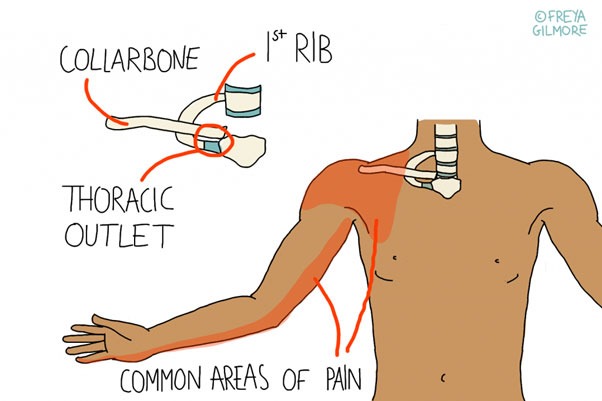The thoracic outlet (confusingly, also known as the thoracic inlet), is a small space between the ribcage and arm. It is the passage for nerves and blood vessels that run to and from the arm. If these structures are compressed or otherwise irritated, they can cause pain and other symptoms in the arm and shoulder.

Symptoms of Thoracic Outlet Syndrome
Symptoms often affect the shoulder and arm, as highlighted in the illustration above. These areas may develop:
- pain, typically achey, which may be constant or it may come and go
- numbness, weakness, or tingling (may be worse overnight)
- loss of control of fine motor movements
There may also be a headache at the back of the head or top of the neck. Raynaud’s phenomenon is another possibility.
Potential Causes of Thoracic Outlet Syndrome
Typically, ribs only extend from the 12 thoracic vertebrae (bones of the spine). However, sometimes an extra one may protrude from the lowest vertebra of the neck: a cervical rib. This can take up more space in the thoracic outlet, predisposing the area to more compression and the development of TOS. However, a cervical rib does not guarantee the development of TOS, and the NHS estimates that only about 10% of people with one will develop the condition. It is very feasible that you could have an extra rib and never know- as long as it does not cause any symptoms that warrant investigation.
Lifestyle and Activity
The space can also be diminished through posture and positioning. A hunched posture or rounded shoulders also compress the thoracic outlet and increase the likelihood of something becoming irritated. If this is the case for you, you might find that your symptoms are worse at work, or while doing other activities that encourage this posture. You might also notice that your symptoms have come on slowly, which may be indicative of slowly changing posture. Desk posture encourages “upper crossed syndrome”, a term that describes tightness in the front of the shoulders and chest, and weakness or over-stretch on the back. This is something we can work on with a combination of exercises and hands on treatment. Typing can be a cause of TOS in itself, so do let us know if you need advice for setting up your desk in a more suitable way.
Sports can play a role in TOS too, especially those that require repetitive throwing. Be sure to mention any sports you play, especially if you’ve only recently picked them up or increased the amount you do.
There are other causes that are beyond your osteopath’s remit: cardiovascular causes such as plaque build-up is one example of this. Trauma, including callous formation over an old collarbone fracture can also play a role.
Nerve vs Vessel
It is important to identify whether symptoms are caused by a compromised nerve, blood vessel, or both. This is because if a blood vessel is restricted, it requires immediate medical attention, and may warrant surgery to release the area. It may also indicate a blockage within a vessel in some cases.
Differentiating between the two can be difficult, but there are some key features to look for in vascular TOS:
- swelling in the arm
- a palpable temperature difference between the affected and non-affected arm
- a change in skin colour between the arms (blueness or paleness)
If these symptoms apply to you, speak to your GP as soon as you can. If symptoms are progressive, call 111.
Managing Thoracic Outlet Syndrome
The most appropriate management strategy depends on the root cause, which your osteopath will work to identify. The verbal case history will give us a good starting point. As part of your examination we will test your symptoms with your neck and arm in different positions to determine the features of your case. If there are no vascular signs, conservative treatments may be the most effective and appropriate for you. This may involve:
- stretching and strengthening
- joint manipulation or mobilisation
- massage techniques
- acupuncture
Exercises can work well in combination with lifestyle changes and other advice. We might recommend heat or ice dependent on your case. A TENS machine might help with pain management, and if there is an association with sport or activity, we might want to modify the intensity or frequency at which you train.
Surgery may be appropriate if the cause is a cervical rib, and this is something that will be discussed with you if a cervical rib is diagnosed. Other indicators for surgery include vascular symptoms and failure to respond to conservative therapies over around three months.
Make an appointment for your arm pain in Leeds here
References
- nhs.uk. 2022. Cervical rib. [online] Available at: <https://www.nhs.uk/conditions/cervical-rib/> [Accessed 17 June 2022].
- Physiopedia. 2022. Upper-Crossed Syndrome. [online] Available at: <https://www.physio-pedia.com/Upper-Crossed_Syndrome> [Accessed 17 June 2022].
- Carnes, M., Vizniak, N. and Vizniak, N., 2011. Quick reference evidence-based conditions manual. [Canada]: Professional Health Systems Inc., pp.80-83.
- Nhsinform.scot. 2022. Raynaud’s phenomenon. [online] Available at: <https://www.nhsinform.scot/illnesses-and-conditions/heart-and-blood-vessels/conditions/raynauds-phenomenon> [Accessed 17 June 2022].